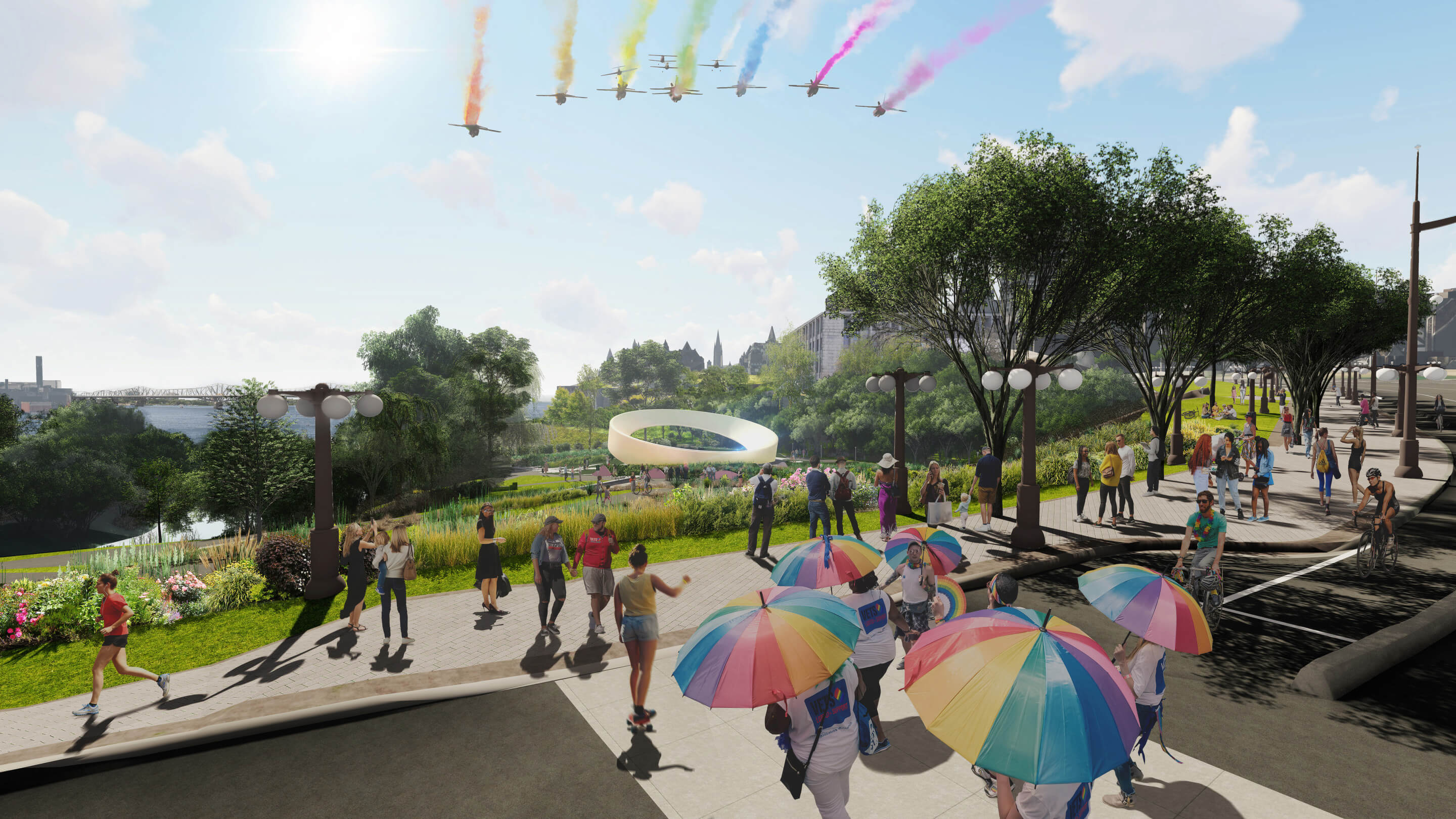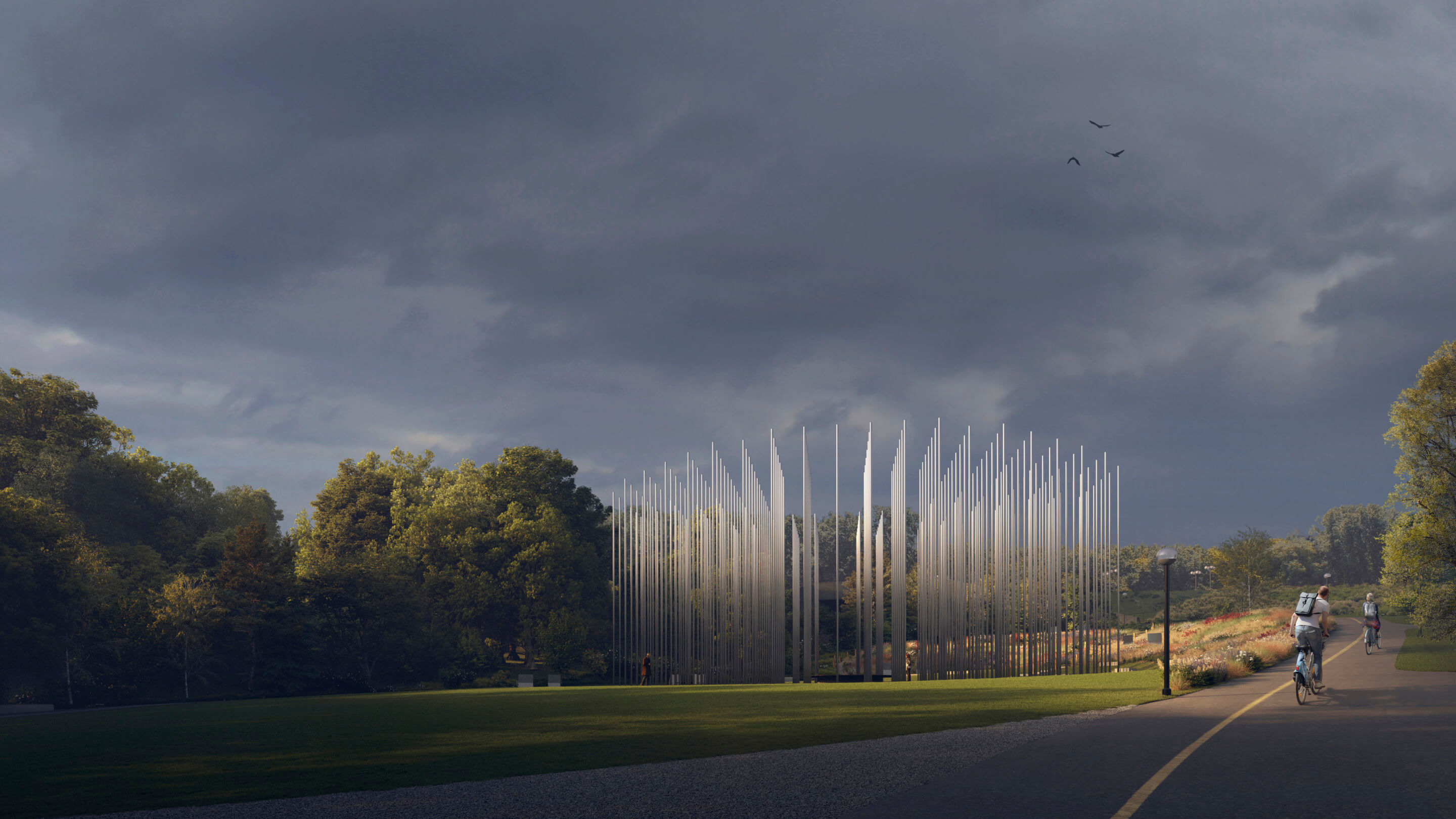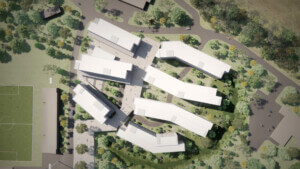Canadian nonprofit the LGBT Purge Fund, working in partnership with Canadian Heritage and the National Capital Commission, has revealed the five shortlisted design proposals for an LGBTQ2+ National Monument in downtown Ottawa. Set to be realized at a prominent site at the intersection of Wellington Street and Portage Bridge near the Ottawa River and the Canadian capital city’s Judicial Precinct, the forthcoming monument aims to “tell the story of generations of LGBTQ2+ people in Canada who have been persecuted, abused, dismissed, and marginalized because of who they love and how they identify.”
While the finalists were announced in February, the teams’ proposed design concepts were unveiled just yesterday. The public now has until November 28 to provide their reactions via a short online survey. From there, the competition jury will review the surveys and take public input into consideration when selecting a winning design, which will be announced this winter. The five multidisciplinary teams are composed of a slew of architecture, urban design, and landscape architecture studios hailing from across Canada as well as international contenders including Skidmore, Owings & Merrill (SOM), MASS Design Group, and MVRDV.
The LGBTQ2+ National Monument is slated for completion by 2025.

As noted in an announcement, the monument, which is meant to “educate, memorialize, celebrate, and inspire,” will not only acknowledge the “enduring injury and injustice” faced by Canada’s LGBTQ2+ communities, it will also set out to confront “the abuse perpetrated by the Canadian state,” chief among these abuses being the LGBT Purge. Carried out from the 1950s through the mid-1990s, the LGBT Purge was the systematic persecution of lesbian, gay, and transgender members of the Canadian Armed Forces, the Royal Canadian Mounted Police, and the Canadian federal public service. This decades-long campaign of harassment, intimidation, and termination was carried out at the highest levels of the Canadian government and impacted an estimated 9,000 individuals over four decades.
In 2018, a historic class-action settlement—the first in the world to award compensation to citizens subjected to state-sponsored discrimination—was reached between survivors of the LGBT Purge and the Canadian government, with a portion of funds not provided as compensation to survivors being earmarked for memorialization and commemoration projects. The LGBT Purge Fund was established to manage projects financed through funds that would have been provided to survivors as part of the settlement if they had still been alive at the time. The LGBTQ2+ National Monument competition launched in October 2020.
Heralding the five design proposals as “inspiring, creative and powerful,” LGBT Purge Fund executive director Michelle Douglas noted that it is “grateful to the design teams for answering the challenge of realizing the vision for this monument and for creating such evocative designs that tell the story of discrimination against LGBTQ2+ communities in Canada. “

“We want as many people as possible to have their say on these designs and be part of the next chapter of this story,” added Douglas, who is also a member of the competition jury alongside, among others, architecture critic and educator Aaron Betsky, landscape architect Grant Fahlgren, urban designer and planner Maya Desai, and Martine Roy, an LGBT Purge survivor and chair of the LGBT Purge Fund’s board of directors.
SOM shared its proposed LGBTQ+ National Monument design with AN, a work titled Bapiiwin. Conceived in collaboration with artists Rebecca Belmore and Noam Gonick along with Winnipeg-based HTFC Planning & Design, Bapiiwin takes the form of hundreds of nearly 30-foot-tall stainless-steel wands polished to a mirrored finish and installed in orderly fashion across a large open field at the monument site. Meant to evoke a grid of flagpoles stripped of their flags, Bapiiwin “announces the importance of the nation’s LGBTQ2+ communities among the buildings and icons of the capital” elaborated the Team SOM design narrative. “Its appearance shifts throughout the day and depending on the viewer’s location, appearing sometimes translucent and sometimes solid, sometimes ethereal and sometimes rooted in the ground. The result is a monument that embodies the contradictions of LGBTQ2+ experience.”
Bapiiwin, along with the four other LHBTQ2+ National Monument design proposals, each complete with an explanatory video, full team details, and a brief design statement, can be found below. More information, including a suite of renderings for each shortlisted design and a link to the public survey, can be found here.
Team Durling | The Lens
Team: Fathom Studio (visual arts and landscape architecture), Two Row Architect (architecture), MVRDV (architecture and landscape architecture)
Design intent: “Dedicated to the queer community, specifically, the survivors of the LGBT Purge, who endured a profoundly discriminatory government campaign, The Lens honours those who speak truth to power, choose action over complacency, and celebrate pride over despair. They carve space from a hostile environment to stand proud, sending out a message of inclusivity and resilience.
Inviting all to ‘come in,’ in the light of day, the pearlescent form rises in delicate contrast to the parliamentary setting. At night, it exudes an other-worldly ephemerality. Inside, it bonds us together, to share experiences, celebrate, and commemorate, holding space for all who enter. The landscape answers in swells and slacks of planting, containing dispersed interpretive installations. Supported by a framework of the seven grandparent teachings, installations in each space tell the stories of community resilience, drawing visitors through the park, sharing unique insights into the community’s history, and a carving path for its future.”
Team MASS Design Group | A Glass Bowl
Team: MASS Design Group (architecture, landscape architecture, and urban design), Stephen Andrews (artist)
Design intent: “Though our stories, traumas and triumphs are myriad we all share the rite of passage of coming out. Our vision combines the intimacy of a singular portal, as a place of transition — where we move from who we were, who we are, and who we can become. Enter the sunken garden where those who endured the purge are honored – their names inscribed in glass. A curtain of water honors tears of sorrow and joy. The mosaic flows into a ramp that becomes a gathering space, a stage and a venue for reflection, activism, and celebration.
In circling back, the path leads you to participate in reclaiming our narrative and encourage others on their journeys. Here, individuals may add to the mosaic with ‘tiles’ of their own. Piece by piece, this surface becomes the story, and moves our collective identity forward.”
Team SOM | Bapiiwin (Survival, Overcoming – Working Title)
Team: SOM (architecture, engineering, and urban planning), Rebecca Belmore and Noam Gonick (artists), HTFC (landscape architecture), Lyle Dick (historian), Iraklis Lampropoulos (audio consultant)
Design intent: “Like a field of flagpoles stripped of their flags, Bapiiwin emerges from the landscape as a matrix of hundreds of stainless steel wands that can be explored in infinitely diverse pathways, reflecting the multitudes of unique paths towards justice for LGBTQ2+ people.
Central to the Monument is a soundscape developed by Rebecca Belmore and Noam Gonick that memorializes the oppression and humiliation suffered under the Purge. Words and sentences researched from Professor Wake’s Ottawa Fruit Machine tests of the 1960’s emanate from a grid of speakers below the ground and surround visitors in a disorienting array.
A central clearing is anchored by a low, heated table that is an invitation to community, dialogue, and healing, and is split into four cardinal quadrants that centre Indigenous experience.
The monument is nested within complementary landscapes. On the one hand a sloping meadow for healing and meditation, and on the other a large communal lawn for festivities and celebration.”
Team Wreford | Thunderhead
Team: Public City Inc. (architecture and landscape architecture), Shawna Dempsey and Lorri Millan (visual artists), Albert McLeod (Indigenous & Two-Spirited People subject-matter expert and advisor)
Design intent: “Our design embodies the strength, activism and hope of the LGBTQ2+ community, and is a lasting testimony to the courage and humanity of those who were harmed by the Purge, homophobic and transphobic laws and norms, and Canada’s colonial history. A thunderhead expands within a huge column, creating an imprint of a cloud clad in mirrored tile: a gleaming space that becomes the monument. It rises up as our community has risen up to say, ‘We demand change.’ A stage extends from the monument’s base for protests and performances, and its interior can host intimate events. Situated in a verdant park, Thunderhead can be approached from a path that traces the history of LGBTQ2+ Canadians, or from a healing circle ringed with stones hand-picked by Two-Spirit Elders. Surrounded by native plants, including a medicinal garden and orchard, this monument is a space for expressions of grief, healing, and celebration.”
Team OnCommonGround | Not yet titled
Team: bbb architects Ottawa Inc., PWP Landscape Architects, WSP Engineering, with visual artists Nadia Myre, Udo Schliemann, and Robert Lepage and LGBT Purge survivors Nicole Crevier and Trudi Fontaine of WSP
Design intent: “This Monument is meant to be felt, not observed. On approach, it presents visitors with an overwhelming wall of concrete, representing the authority of the government’s oppression on its’ own people through the LGTB Purge. A small portal grants access to the Monument space. Passage through the portal presents visitors with visceral reminders of the pain of LGBTQ2+ discrimination: the interrogations of the Purge. Exiting the portal provides relief: A canopy of white pines shelters Imprinted, a sculpture that embodies the simple truth that Love is Love. It is set against the backdrop of a porcelain wall inscribed with the government’s entire apology to LGBTQ2+ Canadians. The sanctum also contains a healing garden for contemplation and a gathering place for PRIDE celebrations. The clearing is bounded by the inside of the authority wall, which has been transformed with 9000 points of light, one for each of the LGTB Purge survivors.”











